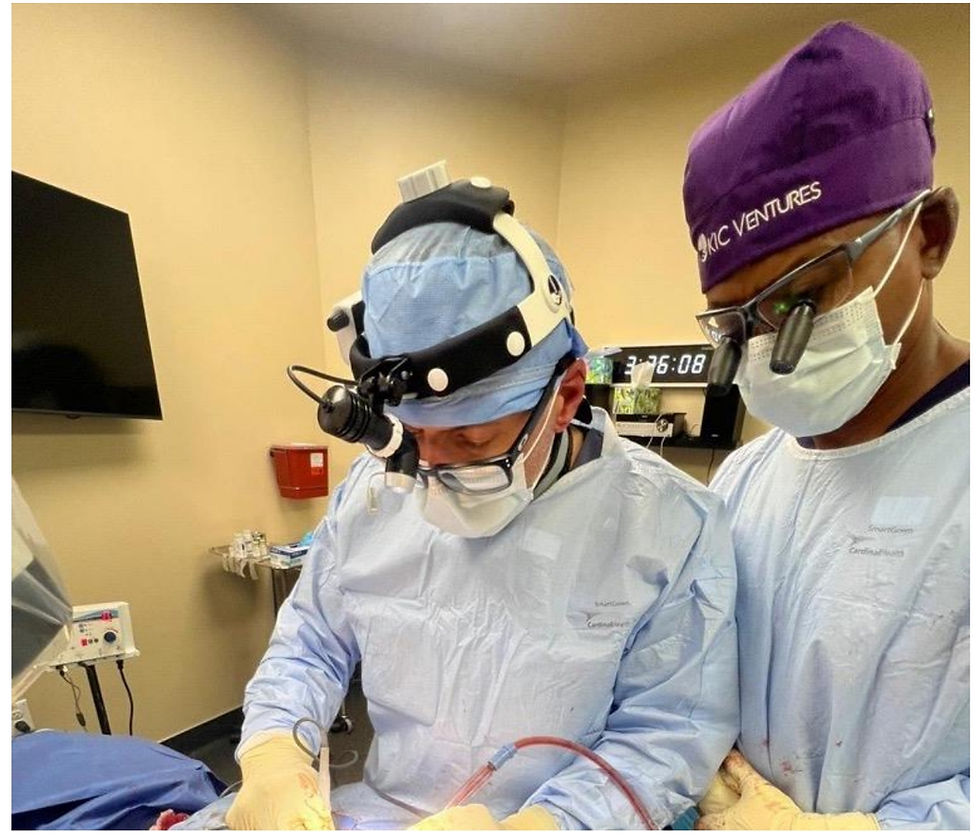Facet Joint Pain Explained: When Fusion Becomes Part of Treatment
- sukanyarao
- Sep 17
- 4 min read
Written by Sukanya Chebrolu, MS and Chukwunonso C. Ilogu, MD, MS of the LESS™ Society

Your spine’s facet joints act like hinges, guiding smooth movement while keeping the vertebrae stable (1,2). When these joints wear down from arthritis, degeneration, or injury, this can result in facet joint syndrome, a common yet often overlooked source of chronic back pain. The pain may stay localized or radiate into the buttocks, thighs, or even shoulders, depending on the spinal level, and it often worsens with standing or twisting. Left untreated, it can lead to stiffness, reduced mobility, and a decline in quality of life. Recognizing and addressing facet joint pain early is key to preserving spinal health and staying active.
Understanding Facet Joint Pain
Facet joint syndrome often develops quietly, with gradual wear and tear that may go unnoticed until pain becomes persistent. Unlike sudden injuries, this type of degeneration builds over time, fueled by aging, repetitive motion, or spinal arthritis. What makes it particularly challenging is that the discomfort can mimic other spinal problems, such as disc disease or muscle strain, which sometimes delays the right diagnosis (3). Advanced imaging, combined with a careful clinical exam, helps pinpoint the facet joints as the true pain source. In some cases, a diagnostic injection can confirm whether the facet joint is indeed responsible for the pain. Early and accurate diagnosis is essential to guide treatment and avoid unnecessary procedures (4).
Treatment Options
Managing facet joint pain usually begins with conservative care such as anti-inflammatory medications, physical therapy, and targeted injections. These approaches help reduce inflammation and improve mobility, often providing meaningful relief.
When symptoms persist, interventions may be considered. Options include radiofrequency ablation, which quiets the pain-signaling nerves, or facet fusion procedures that stabilize the affected joint with minimal tissue disruption (5).
Alongside medical treatments, lifestyle modifications such as maintaining a healthy weight, improving posture, and staying active play a critical role in protecting the joints and supporting long-term spinal health.
When Fusion Becomes Part of Treatment
For patients whose pain persists despite conservative care, modern solutions like FacetFuse™ are changing how spine surgeons approach facet joint stabilization. Unlike traditional open fusion, which can damage healthy tissue and limit motion, FacetFuse™ transfacet fixation is designed to provide targeted relief through a less invasive technique. It represents a new generation of fusion devices that stabilize only the painful joint while aiming to preserve overall spinal mobility. This innovation reflects the LESS Exposure Spine Surgery (LESS™) philosophy and guided by the REP principles - Restore function, Early treatment, and Preserve anatomy:
Restore stability and function at the painful joint;
Early intervention before degeneration worsens; and
Preserve surrounding anatomy and spinal motion wherever possible.
By stabilizing only the affected facet joint through small incisions, FacetFuse™ minimizes trauma and helps protect nearby muscles and ligaments. Patients often benefit from less blood loss, shorter hospital stays, faster recovery, and a quicker return to normal activity, all while maintaining as much spinal mobility as possible (6).
FacetFuse™: Below is an image of the FacetFuse™ screw, a small implant designed to stabilize the painful facet joint. It is placed through a tiny opening and works by holding the joint steady, helping to reduce pain while protecting nearby muscles and tissues.

Image Source: https://www.myfacetfuse.com/ Key Takeaway
Facet joint pain doesn’t have to turn into a lifetime of discomfort or invasive procedures. With LESS™-aligned solutions like FacetFuse™, patients can find lasting relief while preserving spinal function and avoiding unnecessary trauma. These innovations bring the promise of stability, mobility, and a faster return to daily life.
Call to Action
If persistent back pain is holding you back, it could be related to your facet joints. Talk to your spine specialist about LESS™-guided treatment options and whether FacetFuse™ is the right solution for you. Visit the LESS Society to discover more about our commitment to innovative, patient-centered spinal care.
Frequently Asked Questions (FAQs)
1. How do I know if my back pain is from the facet joints?
Facet pain is often worse when bending backward or twisting. A doctor can confirm the diagnosis with a physical exam, imaging, and sometimes a diagnostic injection.
2. What makes facet fusion unique compared to other spinal surgeries?
Facet fusion targets only the painful facet joint rather than fusing larger areas of the spine, offering a more focused solution for patients with facet-related pain.
3. What is recovery like after FacetFuse™?
Most patients experience less pain, shorter recovery times, and faster return to daily activities compared to traditional open fusion procedures.
References:
Lippitt AB. The facet joint and its role in spine pain. Management with facet joint injections. Spine (Phila Pa 1976) 1984;9:746–50. https://doi.org/10.1097/00007632-198410000-00016.
O’Leary SA, Paschos NK, Link JM, Klineberg EO, Hu JC, Athanasiou KA. Facet Joints of the Spine: Structure-Function Relationships, Problems and Treatments, and the Potential for Regeneration. Annu Rev Biomed Eng 2018;20:145–70. https://doi.org/10.1146/annurev-bioeng-062117-120924.
Perolat R, Kastler A, Nicot B, Pellat J-M, Tahon F, Attye A, et al. Facet joint syndrome: from diagnosis to interventional management. Insights Imaging 2018;9:773–89. https://doi.org/10.1007/s13244-018-0638-x.
Yoo Y-M, Kim K-H. Facet joint disorders: from diagnosis to treatment. Korean J Pain 2024;37:3–12. https://doi.org/10.3344/kjp.23228.
Cohen SP, Huang JHY, Brummett C. Facet joint pain--advances in patient selection and treatment. Nat Rev Rheumatol 2013;9:101–16. https://doi.org/10.1038/nrrheum.2012.198.
Chin KR, Seale JA, Bruce CA, Yu WD, Anagnost SC, Kushwaha VP, et al. A comparative cadaveric biomechanical study of bilateral FacetFuse® transfacet pedicle screws versus bilateral or unilateral pedicle screw-rod construct. J Spine Surg 2024;10:354–61. https://doi.org/10.21037/jss-24-10.


Comments